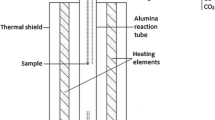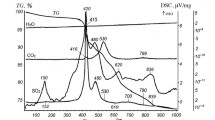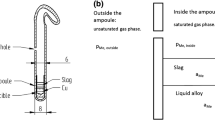Abstract
Four mineral sulfides typically found in the feed stock of a commercial nickel flash smelter, namely pyrite, violarite, pyrrhotite and pentlandite, were isolated from a primary and a supergene ore sample using magnetic separation. Relatively pure samples of pyrite, pyrrhotite and pentlandite were obtained, but violarite could only be upgraded to a 40–50% mixture with pyrite. These samples were characterized by chemical analysis, optical microscopy, Electron Probe Microanalysis (EPMA), Scanning Electron Microscopy (SEM), X-ray Diffraction (XRD) and Thermogravimetry-Differential Thermal Analysis (TG-DTA). Each sample was split into four fractions of particle size 20–45Μm, 45–75Μm, 75–90Μm and 90–125Μm. Ignition temperatures and extents of reaction were determined using an isothermal thermogravimeter, and the products were characterized by electron microscopy. Pyrite and violarite were found to be the most reactive to ignition, followed by pyrrhotite, with pentlandite being the least reactive. This order contradicts the results of other studies and various possible causes for this are discussed. The observed trend of increasing ignition temperature with increasing particle size was in agreement with previously published reports. The extent of reaction of each mineral was measured at increasing furnace preheat temperatures. These plots were correlated with the morphology of the products formed at the ignition temperature.
Zusammenfassung
Mittels magnetischer Trennung wurden aus einer primÄren und einer supergenen Erzprobe vier Mineralsulfide, namentlich Pyrit, Violarit, Pyrrhotin und Pentlandit isoliert, die normalerweise im Einsatzmaterial eines kommerziellen Nickel-SchweberöstschmelzgerÄtes zu finden sind. Von Pyrit, Pyrrhotin und Pentlandit wurden relativ reine Proben erhalten, bei Violarit konnte als Mischung mit Pyrit nur ein Reinheitsgrad von 40–50 % erreicht werden. Diese Proben wurden mittels chemischer Analyse, optischer Mikroskopie, EPMA, Scanning-Elektronenmikroskopie, Röntgendiffraktion und TG-DTA beschrieben. Jede der Proben wurde in vier Fraktionen mit den Partikelgrö\en 20–45m, 45–75m, 75–90m und 90–125m aufgespalten. Zündungstemperatur und Umsatzgrad der Reaktion wurden mittels einer isothermen thermogravimetrischen Methode bestimmt, die Produkte mittels Elektronenmikroskopie beschrieben. Bei der Entzündung zeigten sich Pyrit und Violarit als reaktionsfÄhigste Erze, gefolgt von Pyrrhotin und Pentlandit als am wenigstens reaktionsfÄhig. Diese Reihenfolge steht im Widerspruch zu den Ergebnissen anderer Studien und es werden verschiedene Ursachen diskutiert. Die beobachtete Tendenz, wonach mit steigender Partikelgrö\e auch die Entzündungstemperatur anwÄchst, steht in übereinstimmung mit bereits veröffentlichen Untersuchungen. Der Umsatzgrad wurde für jedes Mineral bei steigender OfenvorwÄrmtemperatur gemessen. Die Ergebnisse wurden mit der Morphologie der Reaktionsprodukte in Zusammenhang gebracht, die bei der Entzündungstemperatur entstehen.
Similar content being viewed by others
References
F. R. A. Jorgenson, Proc. Australas. Inst. Min. Metall., 268 (1978) 47.
J. G. Dunn, S. A. A. Jayaweera and S. G. Davies, Bull. Proc. Australas. Inst. Min. Metall., 290(4) (1985) 75.
J. G. Dunn, T. N. Smith, I. R. Stevenson and L. C. Mackey, Proc. 15th Australes, Chem. Eng. Conf., Melbourne, Vol. 2, 1987, p. 101.
J. G. Dunn, S. G. Davies and L. C. Mackey, Proc. Australas. Inst. Min. Metall., 294(6) (1989) 57.
J. G. Dunn and A. Chamberlain, Thermochim. Acta, in press.
E. H. Nickel, J. R. Ross, and M. R. Thornber, Econ. Geol., 69 (1974) 93.
E. H. Nickel, P. D. Allchurch, M. G. Mason and J. R. Wilmshurst, Econ. Geol., 72 (1977) 184.
W. A. Deer, R. A. Howie and J. Zussman, Rock-Forming Minerals, Vol. 5, Non-Silicates, Longmans, London 1962, p. 146.
J. G. Dunn and C. E. Kelly, J. Thermal Anal., 18 (1980) 147.
J. G. Dunn, G. C. De and B. H. O'Connor, Thermochim. Acta, 145 (1989) 115.
P. G. Thornhill and L. M. Pidgeon, J. Metals, 9 (1957) 989.
Author information
Authors and Affiliations
Additional information
We wish to express our thanks to Dr. R. Hill of the CSIRO Division of Exploration Geoscience, Perth, for providing the two ore samples used in this study. We are grateful for the use of CSIRO facilities, namely the electron probe and the sample polishing equipment. The assistance of several members of the above mentioned Division was most appreciated, in particular Drs E. Nickel, B. Robinson and Mr A. Bowyer. Finally, thanks are extended to Curtin University staff: Ms. J. Steer (XRD) and Associate Professor R. Pidgeon, Applied Geology (Frantz separation).
Rights and permissions
About this article
Cite this article
Dunn, J.G., Mackey, L.C. The measurement of ignition temperatures and extents of reaction on iron and iron-nickel sulfides. Journal of Thermal Analysis 37, 2143–2164 (1991). https://doi.org/10.1007/BF01905584
Issue Date:
DOI: https://doi.org/10.1007/BF01905584




